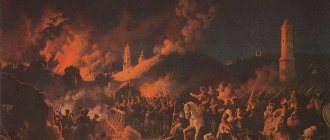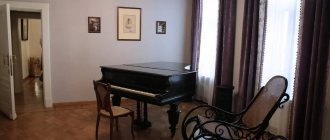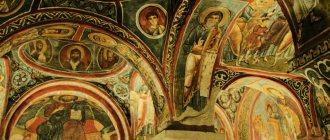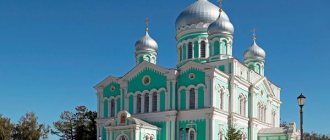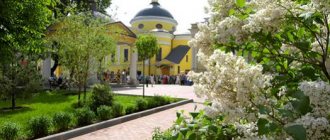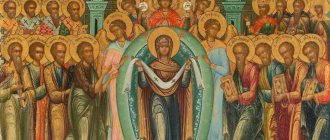Used materials
- Appearance of the Light-Painted Image of the Mother of God in St. Panteleimon Monastery on Mount Athos
[1] According to other sources, “cherek” is the name of a small Turkish coin, which is similar to the word “churek”, meaning bread. It was the distribution of money that outraged the Holy Mountain Kinot, because... in his opinion, the money received could be used for drunkenness. See: Monk Calliopius (Sidorchuk) About the Light-Painted Image of the Mother of God
( )
[2] Magazine No. 97
, Journals of the meeting of the Holy Synod of July 27, 2013 -
Photo of the Mother of God on Mount Athos
The events described took place on August 21, 1903 on Holy Mount Athos. In those days, on the eve of the holidays, in the Russian monastery of St. Panteleimon, there was a custom to help poor monks.
One eyewitness wrote about the distribution of alms: “On Sundays and holidays there is a huge crowd of people in the monastery. The pitiful appearance of the visitors, dressed in rags, half-naked, emaciated and sick, is striking. At first I thought that all these poor monks who came belonged to Rusik (the monastery of St. Panteleimon), but it turned out that these were various ascetics of Athos. Among them you see Greeks, Bulgarians, Moldovans and Russians. All of them are fed at the second meal, after which they go to the cell of the confessor, Father Jerome, where they are given alms prepared in advance.”
A large number of people flocked here; a real queue formed, humbly awaiting alms. It is noteworthy that on that very day this kind of assistance was provided for the last time. The difficult financial situation of the monastery did not allow any more charity work.
One of the monks was holding a camera in his hands. He thought of capturing the historical moment of the distribution of the last alms. Unexpectedly, this same monk, whose name was Gabriel, saw a woman among the crowd of monks! She was dressed all in black. The monk was not taken aback, he immediately took the camera and began filming.
It was the Mother of God herself, the patroness and intercessor of the Holy Mountain, upset that the good work of helping poor monks would be suspended. This is an incredible event, but the film was developed and the image speaks for itself.
The photographer, Father Gabriel, showed the photographs to other monks, and everyone saw this as a sign that they could not stop helping the disadvantaged.
For many years the photograph was kept in the archives of the monastery of St. Panteleimon; It became widely known only in 1997.
Pilgrims see in this photograph confirmation of the great miracle that occurred within the walls of the monastery, and become stronger in their faith. Ecumenical Patriarch Bartholomew also saw this photograph during his visit to the Holy Mountain.
The photograph is located at the entrance to the monastery of St. Panteleimon, to the left of the gate, with the inscription below in Russian and Greek: “The miracle of the appearance of the Mother of God on August 21, 1903,” taken at this place on the last day of distributing alms to the poor with Turkish coins “chereks.”
A chapel dedicated to this event was built nearby, with an artificial fountain in the middle, and in it, on the north side, there is an icon depicting the Virgin Mary with a loaf of bread in her hands.
You can read more about this amazing event, the history of the monastery and photographs here.
History of veneration
| An enlarged copy of the photograph with the image of the Mother of God is now placed at the gates of the Russian Svyatogorsk monastery of St. Panteleimon |
At the end of the 1980s, with the beginning of the restoration of the monastery, the wonderful photograph was reproduced with a brief description of the event and distributed among pilgrims.
For the new generation of Russian people who suffered from atheistic propaganda, photography served as a factor of reassurance in the existence of the spiritual world, which was repeatedly confirmed by pilgrims to the monastery. The celebration in honor of the Painted Image was established by the Council of Elders of the monastery in 2003 with the blessing of the abbot Archimandrite Jeremiah on the 100th anniversary of the appearance for the liturgical perpetuation of the memory of the miraculous event. The name “Image in Light” was born during the preparation of the liturgical sequence (the word “photograph” is a literal translation of the Greek elephant “photography”). At the same time, an iconographic image was created for liturgical use. Based on chronicle records and surviving oral memories, the historical outline of the event was recreated.
The text of the sequence was approved by the Synodal Liturgical Commission.
In 2011, at the site of the appearance of the Mother of God, a memorial chapel was built, into which a source of water was supplied for performing water-blessing prayers. Cases of relief of physical and mental ailments from drinking water from this source have been recorded.
In the same year, on the first floor of the fraternal Pokrovsky building, a paraklis temple was built and consecrated in honor of the Light-Painted Icon.
In 2011, an image of a historical photograph on a marble plaque was installed in the monastery of the Athos Icon of the Mother of God in the village of Chopovichi, Zhitomir region.
A similar marble plaque depicting a photographic image was installed in 2012 at the parish of the Feodorovsky Cathedral in Tsarskoe Selo.
On July 27, 2013, at the regular meeting of the Holy Synod of the Russian Orthodox Church in the Kiev-Pechersk Lavra, it was decided to include in the month book of the Russian Orthodox Church the celebration of the remembrance of the appearance of the Light-painted image of the Blessed Virgin Mary, which was in the Russian Monastery of St. Panteleimon on Mount Athos in 1903 [2 ].
Troparion to the Appearance of the Most Holy Theotokos Illuminated Face
We bow to Your Most Pure Face, O Good One, asking for intercession for us, Mother of God, by the Will of You you have deigned to appear among the brethren, so as to deliver them from the sorrow that You have gathered together. Thus we cry out to You with gratitude: You fill all with joy, O Most Pure Virgin, who entrust themselves to Your Protection.
Kontakion to the Apparition of the Most Holy Theotokos Illuminated Face
Thy indescribable and merciful glance towards man, O most pure Cherub and most glorious without comparison seraphim. And Your Light-revealed and self-depicted Image, evidence of the appearance of Your ineffable love and mercy, we honor with kisses.
Icon of the Mother of God Painted with Light (Icon with Light)
Appearance of the Light-Painted Image of the Blessed Virgin Mary in the Russian Monastery of St. Panteleimon on Mount Athos
September 3, 2013 marked the 110th anniversary of the appearance of the Mother of God in the St. Panteleimon Monastery on Mount Athos. The celebration in honor of the Painted Image was established by the Council of Elders of the monastery on the 100th anniversary of this wonderful event.
On July 27, 2013, at a meeting of the Holy Synod in the Kiev-Pechersk Lavra, a decision was made (journal No. 97) to include in the month book of the Russian Orthodox Church the celebration of the remembrance of the appearance of the Light-painted image of the Blessed Virgin Mary, which was in the Russian Monastery of St. Panteleimon on Mount Athos in 1903.
Event history
On August 21/September 3, 1903, while distributing alms to poor monks at the Great Monastery Gate of the St. Panteleimon Monastery, the monk Gabriel took a photograph and, when he developed it, in a black and white photograph, to his great surprise, he saw the image of the Mother of God humbly receiving the blessed ukruh of bread.
Photo of the miracle of the appearance of the Mother of God
Monastic archives show that between the late 19th and early 20th centuries, Russian monks distributed alms to the needy on a weekly basis. Every week, from the two southern Russian ports of Odessa and Taganrog, where the Athonite farmsteads of the St. Panteleimon Monastery were located, large and small ships with food and vital materials came to the Athonite pier. They were intended for 3,000 inhabitants of the St. Panteleimon Monastery and 4,000 Russian-speaking brothers who labored in various monasteries, metochas, cells and kalivas of the Holy Mountain.
A crowd of poor Syromachian monks and pious wanderers gathered at the Great Gate of the monastery. There is evidence that about 600-800 people received bread cakes - chereks - from the hands of the monks. On scheduled days, people who were doing nothing, drunkenly and obeying no one began to come to the monastery gates for alms. On August 14, 1903, the monastery received a letter from Kinot, which expressed dissatisfaction with the “useless” and “harmful”, in his opinion, alms. The Higher Sacred Administration of the Holy Mountain demanded that the Hierarchy of the St. Panteleimon Monastery cancel the distribution of alms and find a more acceptable and non-tempting form of help. The message, in particular, said: “Alms given in the Gospel are only pleasing and dear to God when they are given in the mind - to people who are worthy of alms and in need of it. Given to people who unworthily present themselves as alms-seekers and who rely only on this visit, and for this reason they live here, then such giving of alms becomes a cause of harm.”
An enlarged copy of the photograph with the image of the Mother of God is now placed at the gates of the Russian Svyatogorsk monastery of St. Panteleimon
On August 21, 1903, exactly a week after receiving the Kinot letter, the monks of the Russian monastery decided to observe the tradition for the last time and give out alms, and only then read the contents of the letter from Kinot to those present. At this time, as usual, hundreds of needy and wandering people had already gathered at the main port in anticipation of alms. During the distribution of chereks, Hieromonk Gabriel took a photograph in which the image of the Mother of God appeared, humbly receiving blessed alms together with other petitioners. Looking at the unusual photograph, the monks immediately remembered the story of the monk Sebastian, who heard from the porters that “one hermit saw a woman several times while distributing chereks.” Some of the ascetics, who also saw the Wonderful Virgin in reality among the wretched monks and alms-seekers, wanted to tell the gatekeeper about this, but on the very day of photographing, no one saw Her.
The Mother of God invariably provided for those who labored in Her earthly lot. At the behest of the Queen of Heaven, the monastery continued to satisfy the needs of the poor brethren: after fraternal meals in the monastery, they organized meals for the poor, and the cellarer gave them food from the warehouse.
History of veneration
At the end of the 1980s, with the beginning of the restoration of the monastery, the wonderful photograph was reproduced with a brief description of the event and distributed among pilgrims. For the new generation of Russian people who suffered from atheistic propaganda, photography served as a factor of reassurance in the existence of the spiritual world, which was repeatedly confirmed by pilgrims to the monastery.
The celebration in honor of the Painted Image was established by the Council of Elders of the monastery in 2003 with the blessing of the abbot Archimandrite Jeremiah on the 100th anniversary of the appearance for the liturgical perpetuation of the memory of the miraculous event. The name “Image in Light” was born during the preparation of the liturgical sequence (the word “photograph” is a literal translation of the Greek word “photography”). At the same time, an iconographic image of the phenomenon was created for liturgical use. Based on chronicle records and surviving oral memories, the historical outline of the event was recreated.
The text of the sequence was approved by the Synodal Liturgical Commission.
In 2011, at the site of the appearance of the Mother of God, a memorial chapel was built, into which a source of water was supplied for performing water-blessing prayers. Cases of relief of physical and mental ailments from drinking water from this source have been recorded.
In the same year, on the first floor of the fraternal Pokrovsky building, a paraklis temple was built and consecrated in honor of the Light-Painted Icon.
In 2011, an image of a historical photograph on a marble plaque was installed in the monastery of the Athos Icon of the Mother of God in the village. Chopoviki Zhytomyr region.
A similar marble plaque depicting a photographic image was installed in 2012 at the parish of the Feodorovsky Cathedral in Tsarskoye Selo.
August 21/September 3, 2013 marks the 110th anniversary of the appearance of the Mother of God.
On July 27, 2013, at the regular meeting of the Holy Synod in the Kiev-Pechersk Lavra, it was decided (magazine No. 97) to include in the month book of the Russian Orthodox Church the celebration of the remembrance of the appearance of the Icon of the Blessed Virgin Mary, which was in the Russian Monastery of St. Panteleimon on Mount Athos in 1903 .


